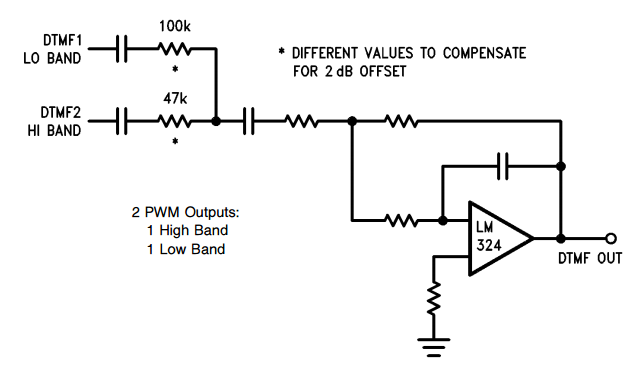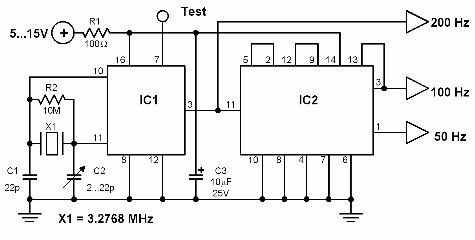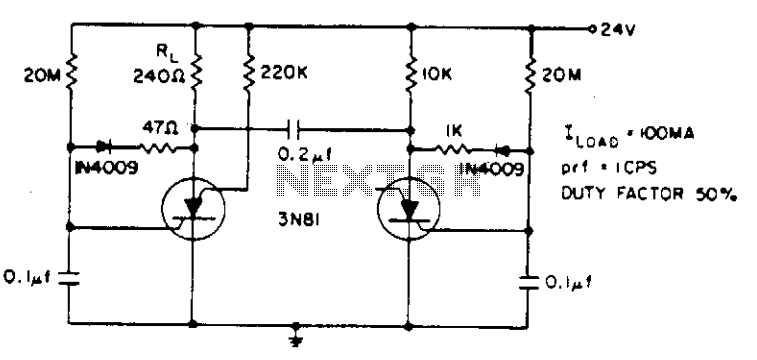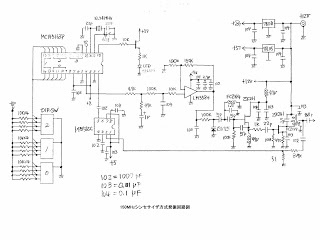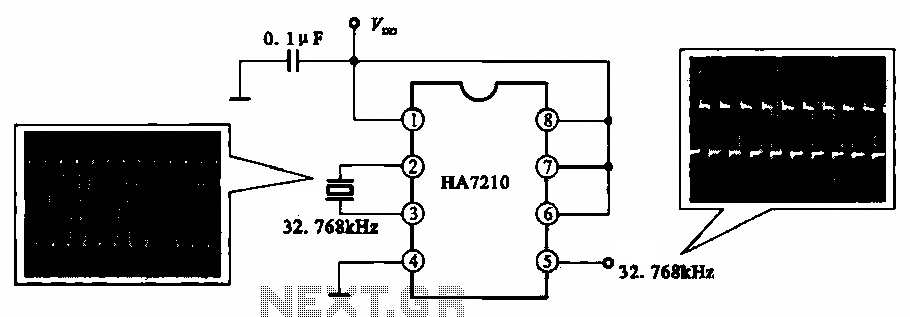
crystal oscillator discreet pierce oscillator
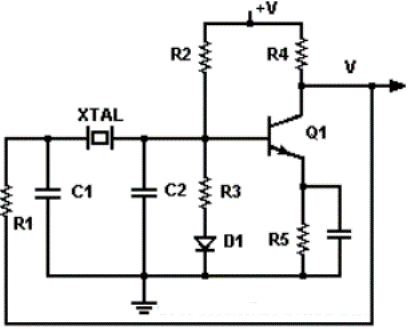
There are various configurations for crystal oscillators, with the most common being discrete and integrated circuits like the Pierce and RLC Bridge. The discrete Pierce oscillator is a suitable choice when good frequency stability and a relatively simple circuit are required. If low cost and a simple digital interface are sufficient, an IC-based Pierce oscillator can be used. For optimal frequency stability, the half-bridge RLC configuration is preferred. The discrete crystal oscillator Pierce offers several advantages, including an operating frequency range from 1 kHz to approximately 30 MHz and a simple circuit design that typically requires only one transistor. The Pierce oscillator produces a high power output signal while consuming minimal power in the crystal. Additionally, the short-term frequency stability of the Pierce crystal oscillator is excellent due to the input circuit's load Q being nearly as high as the crystal's internal Q. The circuit diagram illustrates a discrete Pierce oscillator operating at 1 MHz, where Q1 supplies the necessary gain for self-oscillation. R1 and C1 create a 65° phase delay for the feedback signal. The crystal's impedance consists mainly of a small resistive and inductive component, and this impedance, in conjunction with C2, adds an additional 115° phase lag. The transistor inverts the signal, providing a 180° phase shift, resulting in the required 360° total phase change for the circuit. Since the load is primarily non-resistive, mainly due to the series combination of C1 and C2, this type of oscillator maintains excellent short-term frequency stability.
The Pierce oscillator is a fundamental component in many electronic systems, particularly where precise timing and frequency generation are essential. The configuration typically consists of a crystal, a transistor (or operational amplifier), and passive components such as resistors and capacitors. The crystal serves as a frequency-selective element, defining the oscillation frequency with high precision.
In a discrete Pierce oscillator, the transistor is configured in a common-emitter arrangement, which provides the necessary gain for oscillation. The feedback loop is established through the crystal and the passive components, which ensure that the total phase shift around the loop equals 360° at the desired frequency. The careful selection of R1 and C1 is critical, as these components determine the phase delay that allows for sustained oscillations.
The crystal's impedance characteristics play a significant role in the oscillator's performance. The series resonance of the crystal provides a low impedance path at the oscillation frequency, while the load components help to stabilize the oscillation. The combination of the crystal's inherent Q factor and the additional phase lag introduced by C2 enhances stability and reduces the susceptibility to noise and variations in power supply.
Overall, the Pierce oscillator is favored for its simplicity, cost-effectiveness, and reliability in generating stable frequencies across a wide range of applications, including clock generation in digital circuits, RF transmission, and audio signal processing. Its design principles can be adapted for various frequency ranges and power requirements, making it a versatile choice for engineers in the field of electronics.Although there are many different configurations for Crystal Oscillators, the most common are the discrete and integrated circuits Pierce and environment RLC Bridge. When needed very good frequency stability and reasonably simple circuits, the discrete Pierce is a good choice.
When your main concern is the low cost and the ability of a simple digital interface will suffice with a Pierce oscillator using IC. However, to the best frequency stability, the half bridge is the best option RLC. The discrete crystal oscillator Pierce has many advantages. Its operating frequency spans the full range of basic glass (from 1 kHz to about 30 MHz). Uses simple circuits that require relatively few components (most frequently versions require only one transistor half). The Pierce oscillator design develops high power output signal while dissipating little power in the same crystal.
Finally, the stability of frequency in the short term Pierce crystal oscillator is excellent (this is because in the input circuit of load Q is nearly as high as the internal Q of the crystal). The figure shows a circuit for a discrete Pierce oscillator 1 MHz Q1 provides all the necessary gain self oscillations to occur.
R1 and C1 provide a phase delay of 65 ° to the feedback signal. The impedance of the crystal is basically a small resistive inductive component. This impedance reactor combined with C2 provides additional 115 ° phase lag. Transistor inverts the signal (180 ° phase shift), by providing 360 ° required for total phase change to the circuit. Because the load is mainly non resistive glass (mostly the series combination of C1 and C2), this type of oscillator provides very good frequency stability in the short term.
🔗 External reference
The Pierce oscillator is a fundamental component in many electronic systems, particularly where precise timing and frequency generation are essential. The configuration typically consists of a crystal, a transistor (or operational amplifier), and passive components such as resistors and capacitors. The crystal serves as a frequency-selective element, defining the oscillation frequency with high precision.
In a discrete Pierce oscillator, the transistor is configured in a common-emitter arrangement, which provides the necessary gain for oscillation. The feedback loop is established through the crystal and the passive components, which ensure that the total phase shift around the loop equals 360° at the desired frequency. The careful selection of R1 and C1 is critical, as these components determine the phase delay that allows for sustained oscillations.
The crystal's impedance characteristics play a significant role in the oscillator's performance. The series resonance of the crystal provides a low impedance path at the oscillation frequency, while the load components help to stabilize the oscillation. The combination of the crystal's inherent Q factor and the additional phase lag introduced by C2 enhances stability and reduces the susceptibility to noise and variations in power supply.
Overall, the Pierce oscillator is favored for its simplicity, cost-effectiveness, and reliability in generating stable frequencies across a wide range of applications, including clock generation in digital circuits, RF transmission, and audio signal processing. Its design principles can be adapted for various frequency ranges and power requirements, making it a versatile choice for engineers in the field of electronics.Although there are many different configurations for Crystal Oscillators, the most common are the discrete and integrated circuits Pierce and environment RLC Bridge. When needed very good frequency stability and reasonably simple circuits, the discrete Pierce is a good choice.
When your main concern is the low cost and the ability of a simple digital interface will suffice with a Pierce oscillator using IC. However, to the best frequency stability, the half bridge is the best option RLC. The discrete crystal oscillator Pierce has many advantages. Its operating frequency spans the full range of basic glass (from 1 kHz to about 30 MHz). Uses simple circuits that require relatively few components (most frequently versions require only one transistor half). The Pierce oscillator design develops high power output signal while dissipating little power in the same crystal.
Finally, the stability of frequency in the short term Pierce crystal oscillator is excellent (this is because in the input circuit of load Q is nearly as high as the internal Q of the crystal). The figure shows a circuit for a discrete Pierce oscillator 1 MHz Q1 provides all the necessary gain self oscillations to occur.
R1 and C1 provide a phase delay of 65 ° to the feedback signal. The impedance of the crystal is basically a small resistive inductive component. This impedance reactor combined with C2 provides additional 115 ° phase lag. Transistor inverts the signal (180 ° phase shift), by providing 360 ° required for total phase change to the circuit. Because the load is mainly non resistive glass (mostly the series combination of C1 and C2), this type of oscillator provides very good frequency stability in the short term.
🔗 External reference
Warning: include(partials/cookie-banner.php): Failed to open stream: Permission denied in /var/www/html/nextgr/view-circuit.php on line 713
Warning: include(): Failed opening 'partials/cookie-banner.php' for inclusion (include_path='.:/usr/share/php') in /var/www/html/nextgr/view-circuit.php on line 713
